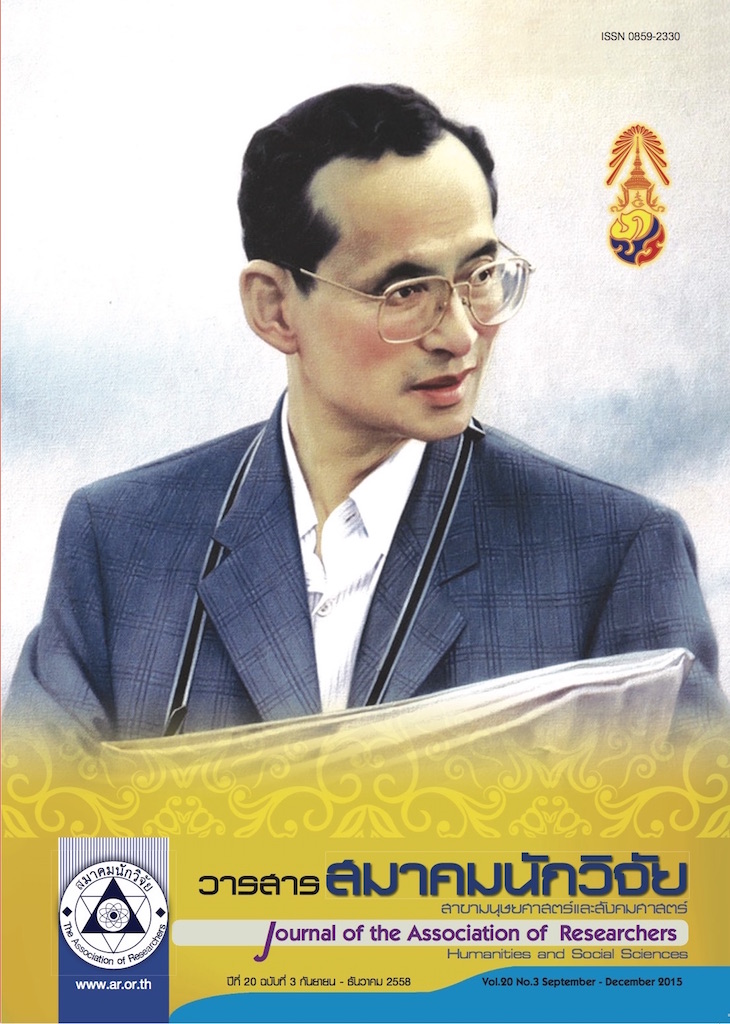Influences of Socially Responsible Leadership and Organizational Citizenship Behavior on CSR Activities Participation of Employees of Government Saving Bank
Main Article Content
Abstract
The objectives of this research were 1) to study the level and relationship among socially responsible leadership, organizational citizenship, and participation in CSR activities of an employee of Government Saving Bank, 2) to study the influence of socially responsible leadership on participation in CSR activities, and 3) to study the influence of socially responsible leadership on participation in CSR activities both direct and indirect via organizational citizenship behavior. The sample was employees of Government Saving Bank at the headquarter office. Judgmental sampling was conducted, and the complete sample size was 500.
. The results found that the correlation coefficient among observable variables was 0.283-0.567, and every variable had a significant level. From structural equation modeling, it found that socially responsible leadership had an influence on organizational citizenship behavior significantly and the variance predicted by socially responsible leadership with 45.2 percent
. Moreover, socially responsible leadership had a direct effect on participation in CSR activities significantly and had an indirect effect via organizational citizenship behavior with significantly and variance predicted by socially responsible leadership with 46.9 percent. Finally, organizational citizenship behavior had a direct effect on participation significantly. Fit indices of the model were x/df = 4.143, CFL = 0.982; NNFI = 0.976; RMSEA = 0.078 และ 99% (C for FRAGE A Fin (0.066
Article Details
บทความที่ปรากฏในวารสารนี้ เป็นความรับผิดชอบของผู้เขียน ซึ่งสมาคมนักวิจัยไม่จำเป็นต้องเห็นด้วยเสมอไป การนำเสนอผลงานวิจัยและบทความในวารสารนี้ไปเผยแพร่สามารถกระทำได้ โดยระบุแหล่งอ้างอิงจาก "วารสารสมาคมนักวิจัย"
References
พิพัฒน์ นนทนาธรณ์. (2553). การจัดการความรับผิดชอบต่อสังคมซององค์กร: การสร้างข้อได้เปรียบในการแข่งขันอย่างยังยืน, นนทบุรี:
ธิงค์บียอนต์ (2555). การจัดการจริยธรรมธุรกิจฐานรากของซีเอสอาร์ กรุงเทพฯ :
ศูนย์ผู้นำธุรกิจเพื่อสังคม (2558). ปัจจัยเชิงสาเหตุของภาวะผู้นำที่รับผิดชอบต่อสังคมที่มีอิทธิพลต่อภาพลักษณ์องค์การของท่าอากาศยานสุวรรณภูมิ, วารสารสมาคมนักวิจัย 20(2), 48-58.
______(2558b), ภาวะผู้นำเชิงปฏิบัติการ: LIFE AModet. (พิมพ์ครั้งที่ 2) กรุงเทพฯ ศูนย์ผู้นำธุรกิจเพื่อสังคม รายงานความรับผิตชอบต่อสังคมและสิ่งแวดล้อม ประจำปี 2556
______(2557). กรุงเทพฯ: ธนาคารออมสิน รายงานความรับผิดชอบต่อสังคมและสิ่งแวดล้อม ประจำวปี 2555. (2556). กรุงเทพฯ : ธนาคารออมสิน รายงานประจำปี 2556.
______(2557). กรุงเทพฯ: ธนาคารออมสิน. รายงานประจำปี 2555. (2556). กรุงเทพฯ: ธนาคารออมสิน
Carroll, Archie (Ed.). (1977). Managing Corporate Social Responsibility.
Boston: Little, Brown, and Company Carroll, Archie B. & Buchholtz, Ann K. (2006). Business and Society (6" ed.). USA:
Thomson South-Western Cheney, G., & Vibbert, S. L. (1987). Corporate Discourse: Public relations and issue management. In F. M. Jablin, L. L. Putnam, K H. Roberts, & L. W. Porter (Eds.), Handbook of organizational communication: An Interdisciplinary Perspective. (pp.165-194), Newbury Park, CA: Sage.
Cohen, John & Uphoff, Norman. (1980). "Participation's place in rural development: Seeking clarity through specificity', World Development, 8: 213-235.
Diamantopoulos, A., & Siçuaw, J. A. (2000). Introducing [ISREL: A Guide for the Uninitiated. Thousand Oaks, CA: Sage.
Hooper, Daire, Coughlan, Joseph & R. Mullen, Michael. (2008). Structural Equation Modeling: Guidelines for Determining Model Fit.
Electronic Journal of Business Research Methods, 6 (1), 53 - 60. Kotler, Philip, & Lee, Nancy. (2005). Corporate Social Responsibility. New Jersey: John Wiley & Sons.
______(2008). Social Marketing: Influencing Behaviors for Good (36 d.) Los Angeles: Sage.
______(2009). Up and Out of Poverty: The Social Marketing Solution. Upper Saddle River: Wharton School Leech, N. L., Barrett, K C., & Morgan, G. A. (2005). SP55 for Intermediate Statistics: Use and interpretation (2nd ed.). Mahwah, NJ: Lawrence Erlbaum Associates.
Moon, Henry, Van Dyme, Linn & Wrobel, Krysia. (2004). "The Circumplex Model and the Future of Organizational Citizenship Behavior Research" in David L. Turnipseed (Ed.), Handbook of Organizational Citizenship Behavior (pp. 1-22). New York: Nova Science Publishers.
Pless, Nicola M. (2007). "Understanding Responsible Leadership: Role Identity and Motivational Drivers* Journal of Business Ethics, 74:437-456.
Porter, Michael E. & Kramer, Mark R. (2006). "Strategy & Society: The Link between Competitive Advantage and Corporate Social Responsibility." Harvard Business Review. HBR.ORG. December.
_______(2011). "Creating Shared Value: How to reinvent capitalism and unleash a wave of innovation and growth." Harvard Business Review. HBR.ORG.
January February Waldman, David A. (2007). Best Practices in Leading at Strategic Levels: A Social Responsibility Perspective in Jay A. Conger and Ronald E. Riggio. (Eds), The Practice of Leadership, San Francisco: Jossey-Bass. www.gsb.or.th/about/index.php www.gsb.or.th/about/policy.php


